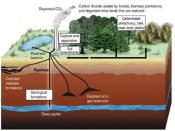�
Table of contents
31. Why free markets are efficient? �
3What are free markets? �
3Market efficiency: marginal benefit equals marginal cost �
52. Government Intervention or Not? �
5Carbon emissions: negative externalities �
5Government Intervention �
6Pros �
6Cons �
73. Why is EU-ETS chosen? �
7What is the European Union Emission Trading Scheme? �
7Long term industry reaction �
84. How does the EU-ETS work? �
8How was it created? �
8Allocation of caps and allowances �
8Price establishment �
9Types of trading allowed �
9Penalty �
105. Is CET helping? �
10CET Today. �
11Is CET reaching the Kyoto Agreement? �
12References �
13Appendix A - Member states and Emission caps �
13Appendix B - Countries that are listed in the UNFCCC �
13Annex I countries (industrialized countries): �
14Annex II countries (developed countries which pay for costs of developing countries): �
14Annex B countries �
15Appendix C - EU-ETS price trading history �
�
�
Why free markets are efficient?
What are free markets?
In economic terms, "free market" is defined as "an economy where all economic decisions are taken by individual households and firms and with no governmental intervention" (Sloman, 2000).
In this, the assumption is made that households and firms make all decisions, and they all act in self-interest. Firms all seek to maximize their profits and are free to choose what to sell and which production methods to use. Consumers all seek to get the best value for money from their suppliers and are free to decide what to do with their incomes. Workers all seek to maximize their wages relative to the human cost of working in a particular job and are free to choose where and to work and how much.
The resulting supply and...


